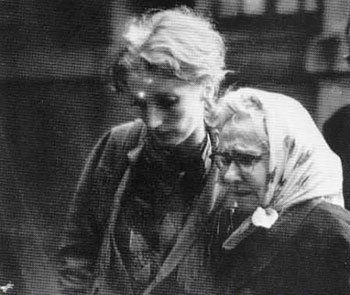How my first college newspaper article opened the door to a world of
"rampant drug use, orgiastic sex and unchecked egotism." Everyone should be so lucky!
 |
| Andy Warhol with Ultra Violet, in 1968 -- the year I met her. |
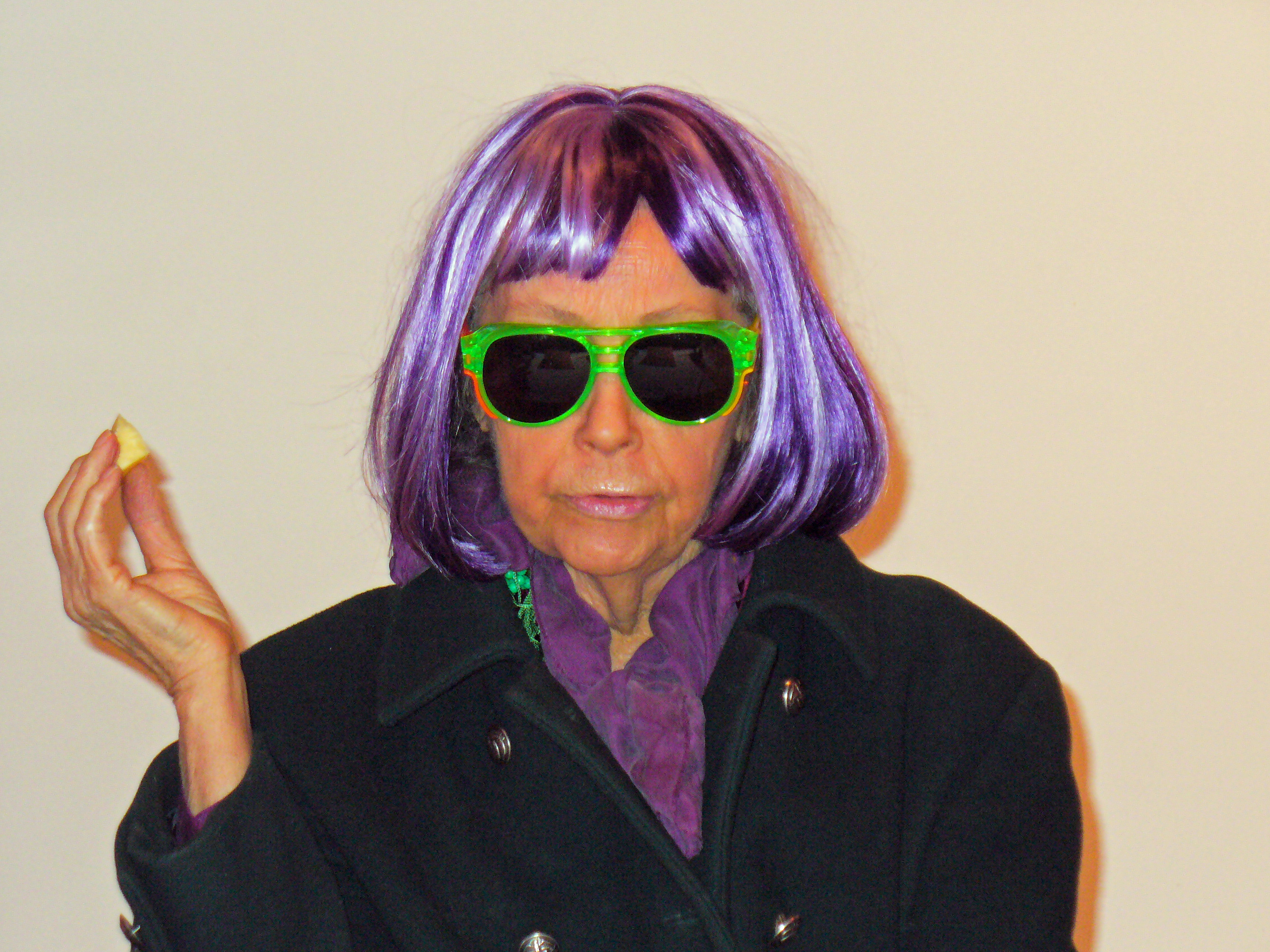 |
| This 2013 photo did nothing to alter my misperception that she was a man in drag. |
(June 26, 2014) It was ironic that the
imposing, glossy-lipped Ultra Violet appraised me coolly and then dubbed
me "Missy Mormon." Almost everyone in New York asked me if I was a
Mormon, since I grew up in Salt Lake City, but no one had ever assigned
me to be one. During my surrealistic afternoon at Andy Warhol's Factory
in the summer of '68, several of the flamboyant characters I met gave me
nicknames (and fashion advice), but I was the antithesis --
deliberately -- of a Mormon girl. The real irony, though, (which I just
learned when Ultra Violet died a couple of weeks ago at age 78) is that
she herself became a Mormon just 12 years after she teased me about my
rosy-cheeked, Goody-Two Shoes image. According to the New York Times obit, she ultimately rejected "the rampant drug use, orgiastic sex and unchecked egotism" at the
Factory.
When
I was there, The Gang was still shakily recovering from the drugs and
sex the night before, so I remained reasonably pure, but I got to see
lots of egotism, and it was quite entertaining.
Another irony is that I assumed Ultra Violet was a drag queen until I read her death notice. I was completely taken aback to learn that she was a woman, through and through. I am so confused. I guess you could say she was a woman dressed like a man who is impersonating a woman. What other bizarro world shenanigans did I fail to detect? Were there other women I mistook for men in drag? I'll get to that later. It was a mishmash, to say the least. Maybe the whole scene was performance art, designed to mess with my head. But it didn't -- I just had fun.
 |
My expose of Andy's fraud is what got me into The Factory. I said, "Can I come meet the real you?" He said, "OK." |
The place was filled with dudes in ravishing wigs, the highest high heels I'd ever seen, and makeup galore. One wore
a marigold tutu and mink eyelashes, and another was dressed like Jackie
Kennedy in the famous pink Chanel suit and pillbox hat. The ballgowns
and lingerie were divine. I loved the feather boas, but miniskirts on
men -- even gorgeous ones with impeccable manicures and stunning
cleavage -- don't generally look quite right.
 |
| A Warhol satire of the Annie Liebovitz approach to portraiture. Being straight is so lame! |
(There was also a pack of "Peter Pan's boys" roaming aimlessly around the cavernous, dimly lit Factory's central space, whose walls were covered in aluminum foil. Some were pouty and pretty, slender and wan. Others, in leather pants, were topless, looking fierce and flexing their muscles. The pretty boys fussed over me, urging me to grow out my hair and conceal my sprinkling of freckles. One put a Cracker Jack "diamond ring" on my finger and said, "Oh darling, we are now officially married!")

The drag queens were glorious satires of female glamor (and I guess I could have been regarded as a humorous satire of The All-American Girl). It was through them that I experienced my first "air kisses," which I'd never heard of and would never hear of again for many years. I was glad they weren't really, physically smooching me on the lips and cheeks -- I was shy about receiving such gestures -- but it kind of hurt my feelings, too. Was there something about me that made them not want to get too close? The air between their lips and my face was vast and perplexing. Now you see air kissing everywhere. It is very silly, people!
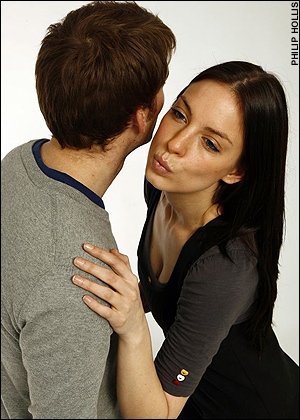 |
| Why bother? |
We should take our cue from the French or the Italians, and greet people in a heartfelt, authentic way. Or just go back to saying, "Hi."
Nevertheless, I was inspired by the concept implicit in the "queens'" fabulous disguises: That we are all free to remake ourselves into whatever we wish to be. It was exhilarating. I have been fascinated since that day by transvestites, transsexuality, homosexuality and gender issues in general.
But I was there to interview Andy Warhol, not to ponder all this mind-boggling fluidity. Since I was only 18 years old, this would have been quite a coup,
but unfortunately, Andy had been shot by a disgruntled friend, Valerie Solanas, the day before, and was in critical condition. The
bullet entered Andy’s right side and went straight through him, coming
out the left side of his back.
 |
| Valerie had published the anti-male S.C.U.M. manifesto. |
I had just arrived in New York for a two-month summer internship, having already arranged with Andy's manager/collaborator Paul Morrissey (who later discovered and signed The Velvet Underground) to spend the afternoon of June
4 with Andy. I had been ecstatic. This would be the coolest
thing I'd covered since the Black Panther Convention.
 |
| Andy was shot June 3, the day before our scheduled interview. |
(My two-month internship coincided precisely with Andy's two-month hospital stay. Was that another of his pranks? "I'll get out the moment she goes back to Salt Lake City! Ha, ha!")
"Andy's not the only attraction at this zoo," Morrissey told me when I called him from the Barbizon Hotel and heard the news about the attempted murder. "Why don't you come tomorrow anyway, and experience this freak-show firsthand?" He told me he'd also let me screen the "rough cut" of an upcoming Warhol film.
 |
| This isn't the one I saw, but the title probably says it all. |
As a freshman journalist working for my
college newspaper, I had exposed one of Warhol's most notorious capers four months earlier. I had covered his appearance on campus -- which consisted of a grainy,
ponderous, pointless film, followed by a listless Q&A session with the artist. In my article, I openly
questioned whether this inarticulate pretty boy really was Andy, who I
had read in Time magazine was a painfully homely and acne-scarred mama's boy who wore a poorly fitting blond wig.
 |
| The fake Warhol. Darn cute. |
 |
| The real Warhol. He was insecure about his looks. I know the feeling! |
(My job had been to cover Andy's appearance as a news event, but I didn't understand that. I was 17 at the time, and I took it upon myself to add my own scathing critique of his film to my "objective" coverage of the gathering. It is very embarrassing now to recall my imperious bludgeoning, and my sputtering ridicule, of his movie. No one in the journalism department or among our 23,000 readers objected to my rather-too-gleeful attack, but I was wrong to comment, and I am sorry I did it. For all I know, it wasn't an outrageously stupid, insulting movie at all. In any case, my opinion was not relevant.)
Factory regular, Viva, and Andy Warhol's mother, after the shooting
My Warhol coverage became explosive when Morrissey
admitted to the Associated Press that the man representing himself as Warhol on a far-flung campus lecture tour was a "fill-in." An impostor, a poseur, a flagrant fraud!
It was actually just an extension of Andy's "art," Morrissey explained. As in: What is art? Who
is the artist, really? Is his art really "his," or is it a collaborative product resulting from his exposure to other art, to people, and to the world around him? Isn't everyone the artist, including we who view and interpret the art through our own prisms? Where is the line between truth and fiction? What does it matter?
This stunt was entirely consistent with the
Warholian approach to life. At the time, I thought it was absurd. Now I
believe it is an absurdist, and legitimate, point of view. Where is the line between truth and fiction? What does it matter? There is profound truth in lies, and our "truths" are just our attempts to explain why things are as they are. They are hypotheses that become personal mythologies. Neuroscience backs this up.
 |
| Paul Morrissey was ridiculously handsome. It almost seemed rude. |
But even before I realized this, I wasn't mad at Andy for ripping off all those colleges. I identified with his fear of being scrutinized. Perhaps he felt that his appearance would detract from his perch as a Golden Boy in the glittering art world, where image was everything. I felt sorry for him. And now that I am kind of old, I identify with him even more. He was shy and lonely -- combined with a dollop of megalomania and sociopathy -- and he made the most of what he had to work with.
 |
| The Factory had aluminum foil on the walls. There were groupings of people and projects everywhere. |
 |
| Socialites, derelicts, art dealers and dope dealers roamed around, looking for some action. |
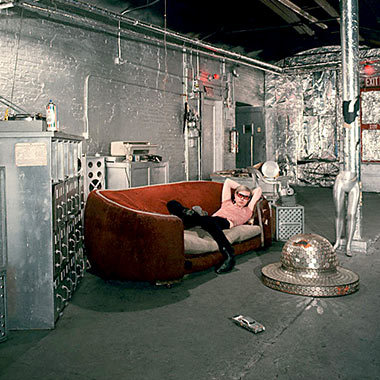 |
| Andy had his own lay-about couch that others were forbidden to use. |
I was in no position to scorn Warhol's character. I myself was an opportunist -- somewhat ruthless and dishonest, at times -- which really is a beneficial quality if you don't take it too far. Even though I had subjected Warhol to national outrage, and possibly humiliated him (I hoped not), I dared to request an audience with my victim. I knew that an interview with the reclusive artist would further my career, but it would also give him a chance to articulate his philosophy in a way that I could help make comprehensible to regular people, who know what the meaning of "is" is.
Morrissey was right about The Factory: Even without the presence of Warhol, there were plenty of animals in the zoo. They were cute, they were freaky, they were ravishing, and they were wrecked. Some looked me up and down as if they were cannibals, fantasizing about their next meal. Most of them ignored me.
Morrissey was jaw-droppingly cute. I think he was the only person I saw all afternoon who seemed like a regular guy. He was a gracious and protective guide as I made my way through the Factory's various spaces and "secret spots," and then he took me to the screening room.
We were joined by a critic from the Evergreen Review. I was astonished that I would be viewing a new film with a writer from such an esteemed counterculture medium.
 |
| Evergreen had a roster of the finest writers in the world. |
But I was more astonished when the lights went down. There I was, sitting with two men, as a naked Cheryl Tiegs sat in a dingy motel-room bed, smoking hopelessly. Nothing happened during the entire film, except that she sighed, rolling her eyes, and shifted positions occasionally.
For years, I had been familiar with Tiegs as the famous, and famously wholesome, fashion model. Why did she agree to appear in such an artless, sordid movie? And, more pressingly, how did her breasts get so droopy and deflated, like the ladies in National Geographic who had nursed a whole lot of kids? And why were her nipples so huge? Is that the way they're supposed to be? I surely hoped not!
 |
| What were you thinking, Miss Tiegs? |
The film was mercifully short, and then Paul suggested that I go to an "avant garde" theater in Greenwich Village and watch a "fantastic" Warhol release, which he felt would enrich my understanding of "The Peter Pan of Pop Art."
Like the teenage hick I was, I walked (and even skipped) all the way down there from 63rd and Lexington the next day, expecting to find a charming "village," with flowers spilling out of window boxes and lots of creative dynamism in the air.
 |
| Oops, I did it again. When I asked where the theater was, they seemed amused. |
I guess they were amused because it was a gay porn theater, which I wouldn't realize until I was in there, eating popcorn, in the dark. It seemed odd that it was so empty, and it was all men, and most of them were slumped down, by themselves.
Then the movie began. OMG. I had gay friends at college, and I had kind of imagined what their "interactions" might be like, but I was quite unprepared for the grunting energy and contortions that were involved. Shit, you guys: Are you "making love" or trying to kill each other?
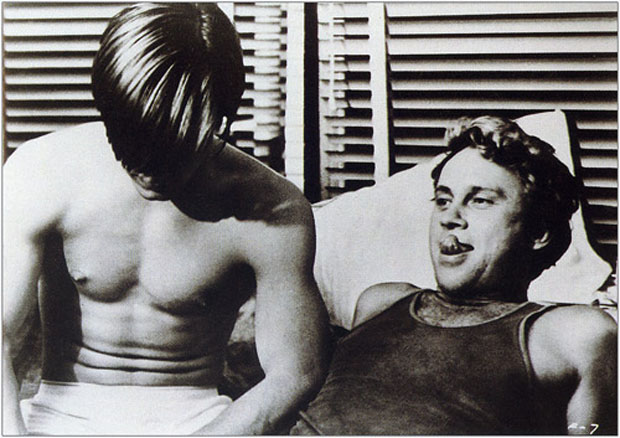 |
| This was the calm before the sexual storm. |
I wanted to get out of there, but I was paralyzed. I felt fear, which I knew was irrational. I didn't want to call any attention to myself. My heart was pounding and I was flushed and gulping. I was feeling this movie, and it hurt. I vowed never to have a prostate exam, no matter what anyone told me about how important they are. I finally girded up my trembling loins and ran into the street, and for the first time in my life, I hailed a cab. That was a cool experience.
Mr. Morrissey, you misjudged me. I was a teenage girl who would not really warm up to butt-fucking (among men, not me) for several years. Now I see the pleasure and sexiness of it for those involved, but on that afternoon, it just gave me a massive bout of diarrhea after I got back to the Barbizon. Did you send me to that theater as a hilarious joke, or did you really believe I was mature and open-minded enough to handle it? My lower bowel is aflame just from sitting here writing about it.
 |
| (Ouch.) |
In the 46 years since then, and in the 25 years since he died at age 58, Warhol seems only to have grown in prominence and influence. If you do a search for him in the New York Times, you'll discover that there is at least one mention of him in the paper almost every day, and sometimes more. He is credited for helping to shape not only art, but also fashion, music, dance, gender studies, interior design and philosophy.
 |
| Isn't this taking things a bit too far? Let's find another topic, people! |
There are several Warhol museums, and a planned Lower East Side development -- one of the largest in the city -- is expected to include yet another. Warhol exhibitions and auctions are taking place constantly, here and around the world.
 |
| An auction last fall. Photo by Andrew Morton/Getty Images |
An exhibition at the at Skarstedt Gallery in New York that paired 10 of Warhol’s Oxidation Paintings (1977-78) with 12 of Yves Klein’s Fire Paintings
(1961) ended June 21. It represented the first time the two artists had
been shown together. An Andy Warhol exhibition was held at Tate Liverpool earlier
this month, and he was the star at the Mac Gallery in Belfast last
month.
 |
| An Irish girl loses herself in Warhol's meandering imagery. |
In mid-June, a Warhol self-portrait priced at more than $30 million led the rush of early sales at the V.I.P. preview of Art Basel, the world’s pre-eminent fair devoted to modern and contemporary art, according to Arts Beat.
 |
| "Fright Wig" was frightfully expensive. |
In early June, a new vogue-ballet in drag, inspired by
Warhol, premiered in New York. It is titled "Drella," a mash up of
Dracula and Cinderella, which was Warhol's nickname.
 |
| "Drella" -- a tribute to Warhol by John Cale and Lou Reed. |
The Andy Warhol Museum in Pittsburgh and the Museum of Modern Art, which
holds Warhol’s film archives, are beginning a project to digitize the
materials, almost 1,000 rolls, a vast undertaking that curators and
historians hope will, for the first time, put Warhol’s film work on a
par with his painting, his sculpture and the Delphic public persona that
became one of his greatest works. It will be MoMA’s largest effort to
digitize the work of a single artist in its collection. (http://www.nytimes.com/2014/08/14/arts/design/digitizing-warhols-film-trove-to-save-it.html?action=click&pgtype=Homepage&version=Moth-Visible&module=inside-nyt-region®ion=inside-nyt-region&WT.nav=inside-nyt-region).
Two seminal paintings by Warhol
from the 1960s — “Triple Elvis [Ferus Type]” from 1963 and “Four
Marlons” from 1966 — will be put up for sale at Christie’s Rockefeller
Center auction house on Nov. 12. While Brett Gorvy, Christie’s worldwide
chairman of postwar and contemporary art, is cautiously estimating the
paintings could bring $140 million together, he added that each has the
potential to top the $100 million mark, perhaps even outperforming
Warhol’s “Silver Car Crash (Double Disaster),” a two-panel painting from
1963, which brought $104.5 million at Sotheby’s in last year. (www.nytimes.com/2014/09/05/arts/design/warhols-presley-and-brando-head-to-auction.html)
I've always thought Warhol was highly overrated as an artist, although I don't really have any standing to express an opinion. I do think, though, that like Marcel Duchamps, his work and life made people think about the nature of art and how it is regarded -- as beauty, as commerce and as a thing that you buy for god knows what deep-seated motive. He gamed us, and we played along. He mocked us, and we loved him anyway. He did it his way, and his 15 minutes of fame has become an eternal flame.
ADDENDUM: Back to Ultra Violet. If she was a woman, had there been others I had misidentified as cross-dressers? I was stunned this week to learn that two of Andy's best-known "queens" were also women. Sorry, Candy and Viva! You sure fooled me, by working so hard to be feminine that I thought you were men!
 |
| Candy Darling: I was sure she had something "down there" that ladies don't have. |
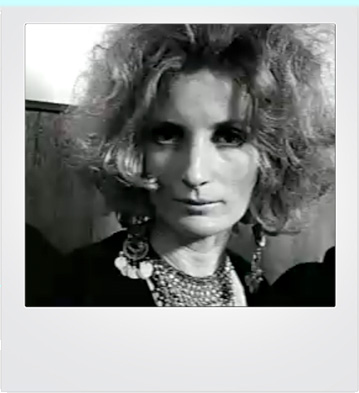 |
| Viva had a handsome, pensive face, and thought smiling was uncalled-for. |
I accidentally created my own Warhol portrait a few years ago, and I have no idea how it happened. I must have hit some secret combination of computer keys (maybe my cat did it), when I was sizing a photograph, and I have never been able to do it again. The photo depicted my first Lupus flare. I have tried several times to make a copy of this work of "pop art," and it's never worked until I succeeded, just now, as I was writing this post. Andy: Is that you? Maybe he's still up to his old tricks, and laughing all the way to the Celestial bath house:
 |
| Thanks, Andy. I love the concept of disease as art. It makes me feel better. |
I love the concept of me matching Cassius Clay as well.



